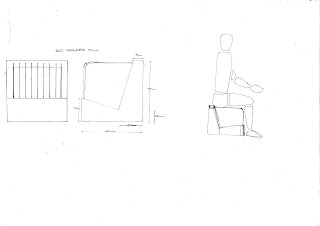Friday, 19 April 2013
Scale Prototype
Due to the lack of appropriate materials, the scale prototype does not include the metal rods which act as the seating plane.
This 1:5 scale model is made from a single cardboard net, cut and folded to produce this shape. This model has opened up the possibility of perhaps replicating the net and making it out of laser cut steel for the full sized prototype, instead of wood. The advantage of having a laser cut steel sheet may be in reducing the overall mass and also increasing the precision of hole alignment for the steel rods, by reducing the tolerances often attributed to human error during manufacturing with wood.
This 1:5 scale model is made from a single cardboard net, cut and folded to produce this shape. This model has opened up the possibility of perhaps replicating the net and making it out of laser cut steel for the full sized prototype, instead of wood. The advantage of having a laser cut steel sheet may be in reducing the overall mass and also increasing the precision of hole alignment for the steel rods, by reducing the tolerances often attributed to human error during manufacturing with wood.
Further Concept Development
Considering the potential difficulty of actually being able to make a prototype of my previous preferred outcome from the ideation, I have developed my second favourite design, which I believe to be a more achievable design, considering the time constraints on this project and also my metal working know-how.
For this design I explored what possible shapes can be made within the 400mm^3 volume stool. I preferred to keep the walls of the design all perpendicular to the ground as to keep within the cube shape.
I also considered the ability of all of the sub-varieties of this stool to be stacked, as is helpful in a cafe, the most likely setting for such a stool.
I also considered the ability of all of the sub-varieties of this stool to be stacked, as is helpful in a cafe, the most likely setting for such a stool.
I do not yet know what sizes of steel rods are available to me, so I have not yet decided on how many will be included in the final design.
Friday, 12 April 2013
Scale Prototype
The images above are of a scale model of my preferred design outcome. The scale of the model is 1:5 and is made from construction paper. Despite the material the structure is strong and can balance weight quite well, though I believe it may help to add supports behind the hanging columns to strengthen it in the axis running perpendicular to the curved seating plane. The final 1:1 scale prototype will likely have to be made from sheet steel and due to the small radius in the curve lines, will most likely require some cutting to aid bending.
I worked on various shapes and sizes for this particular stool until I was happy with how it was proportioned. The dimensions of the single sheet of construction paper I used to make this are 380mm x 80mm. The radius of the curved surface is 110mm and the length and width of the columns are 50mm by 20mm.
Tuesday, 9 April 2013
Tuesday, 2 April 2013
Material Experimentation: Cardboard
To better demonstrate how lightweight materials can support a disproportionately large mass, I created two structures out of cardboard, using curved bend lines to create curved surfaces. This enabled the cardboard structures to support hundreds of times its own mass. The design in the top photo was the heaviest of the two, using multiple pieces cardboard. This design was the most stable, however it could not handle as much weight as the design in the second photo, this is because the surfaces supporting the mass during testing were not curved enough; after minor changes to the design (increasing the crown in the surfaces) the structure was able to support more weight. The design in the second photo was able to support the most weight, whilst still being the lightest, having only been made from a single piece of cardboard. The one problem this design did make very apparent was that the mass was not being distributed in such a way that did not cause buckling and twisting.
From this I learned that reinforcement of materials is not always the best way to strengthen a structure. It has become clear that clever design, through smart material choices and adjusting curvature can drastically improve results, especially when the mass of a piece of furniture is of great concern, second only to the safety of the person using the product.
Subscribe to:
Comments (Atom)
.JPG)
.JPG)





.jpeg)
.jpeg)
.jpeg)
.jpeg)


















.JPG)